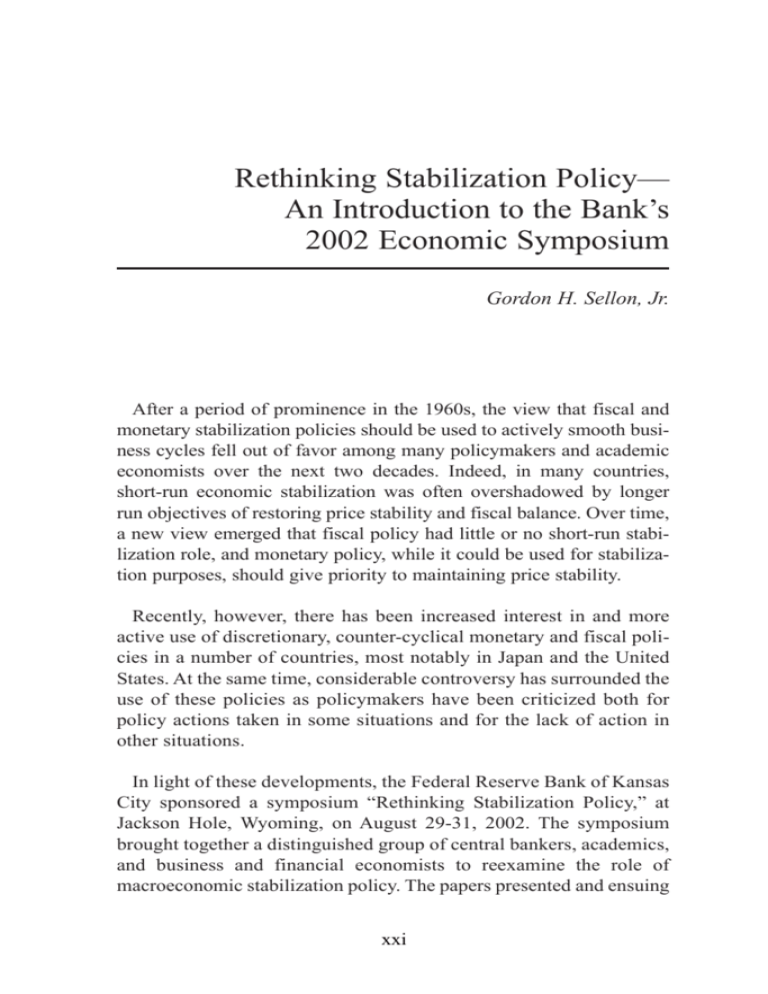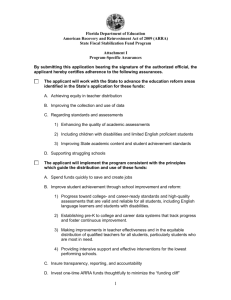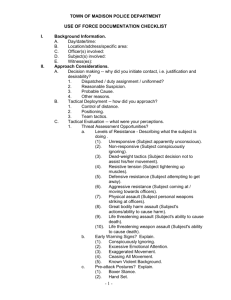Rethinking Stabilization Policy– An Introduction to the Bank's 2002
advertisement

Rethinking Stabilization Policy— An Introduction to the Bank’s 2002 Economic Symposium Gordon H. Sellon, Jr. After a period of prominence in the 1960s, the view that fiscal and monetary stabilization policies should be used to actively smooth business cycles fell out of favor among many policymakers and academic economists over the next two decades. Indeed, in many countries, short-run economic stabilization was often overshadowed by longer run objectives of restoring price stability and fiscal balance. Over time, a new view emerged that fiscal policy had little or no short-run stabilization role, and monetary policy, while it could be used for stabilization purposes, should give priority to maintaining price stability. Recently, however, there has been increased interest in and more active use of discretionary, counter-cyclical monetary and fiscal policies in a number of countries, most notably in Japan and the United States. At the same time, considerable controversy has surrounded the use of these policies as policymakers have been criticized both for policy actions taken in some situations and for the lack of action in other situations. In light of these developments, the Federal Reserve Bank of Kansas City sponsored a symposium “Rethinking Stabilization Policy,” at Jackson Hole, Wyoming, on August 29-31, 2002. The symposium brought together a distinguished group of central bankers, academics, and business and financial economists to reexamine the role of macroeconomic stabilization policy. The papers presented and ensuing xxi xxii Introduction discussion focused on a number of key issues including: reasons for a renewed emphasis on stabilization policy, whether and when stabilization policy can be effective, limitations on the use of stabilization policy, and whether the use of stabilization policy to reduce business cycle fluctuations conflicts with the pursuit of long-run price stability and fiscal sustainability. This introduction provides some brief background information on how views about stabilization policy have evolved over time, highlights two key themes that emerged in the symposium discussion, and summarizes some of the main points of agreement and disagreement among symposium participants. Evolving views about stabilization policy The term “stabilization policy” has traditionally been used to describe the use of monetary and fiscal policy to smooth business cycle fluctuations. These policies generally encompass both discretionary changes in fiscal and monetary policy resulting from specific policy decisions and automatic stabilizers that occur when taxes and spending respond to changes in economic activity. According to traditional views of stabilization policy, monetary and fiscal policy can moderate the business cycle by offsetting changes in aggregate demand by consumers and businesses that would otherwise cause inflationary pressures or weaker economic activity. In the late 1950s and early 1960s, belief in the efficacy of stabilization policy to moderate business cycle fluctuations was widespread among policymakers and academics and resulted in a number of attempts to use fiscal policy to increase or slow the pace of economic activity. By the early 1970s, however, optimism about stabilization policy began to wane, and by the early 1980s, few policymakers or academics remained enthusiastic about its use. There are a number of possible explanations for this turn of events. One reason is that, in practice, stabilization policy appeared to be less effective than anticipated. For example, studies of the response of consumer and business spending to discretionary tax changes in the 1960s Introduction xxiii and 1970s reached differing conclusions about the effectiveness of these policies. Moreover, in the early 1970s, restrictive monetary policy did not appear to be successful in lowering inflation. A second reason is that the nature of the shocks hitting the economy was somewhat different in the early 1970s. Increases in food and energy prices and a slowdown in productivity growth meant that aggregate supply factors became more important determinants of economic activity. Such shocks are not as amenable to traditional stabilization policies. A third reason is that new academic research, in particular the development of the literature on “rational expectations,” undercut some of the theoretical justification for the active use of stabilization policy. Moreover, by the early 1980s, the focus of fiscal policy had changed from short-run stabilization to issues of growth and economic efficiency. Finally, policymakers faced a different set of policy challenges from the mid1970s on, as high inflation and rising government deficits and debt levels caused policymakers to give priority to restoring price stability and fiscal balance. In light of these developments, it is perhaps surprising that there has been a renewed interest in the use of stabilization policy over the past decade, most notably in Japan and the United States. Monetary and fiscal policies have been aggressively employed in both countries in recent years to counter persistent weakness in economic activity and episodes of financial instability. The revival of stabilization policy has not been universal, however. In contrast to the United States and Japan, the countries in the European Monetary Union have been more reluctant to endorse an active use of stabilization policy as a prescription for weaker economic activity. Moreover, some other countries, such as Canada, have made increased use of discretionary monetary policy while continuing to eschew the use of discretionary fiscal policy. Key themes A principal objective of this year’s symposium was to develop an understanding of the renewed interest in stabilization policy and the differing views as to its effectiveness. In the course of the discussion, two key themes emerged: the relationship between short-run stabilization policy and longer run objectives of price stability and fiscal xxiv Introduction balance and the challenges for stabilization policy posed by a changing economic environment. Consistency of stabilization policy with longer run objectives Much of the symposium discussion revolved around the questions of whether and how short-run stabilization policy can be reconciled with maintaining price stability and fiscal balance. That is, does active use of stabilization policy potentially compromise achievement of price stability and fiscal balance? Alternatively, does maintaining price stability and fiscal balance constrain the scope for stabilization policy? A general conclusion that emerged from the symposium papers and discussion is that while there is still an important role for short-run stabilization policy, its scope is definitely limited by the need to maintain price stability and fiscal balance over the longer term. Moreover, the role that stabilization policy can play is likely to vary from country to country depending on the nature of shocks and the economic structure, whether a country has a credible record of achieving price stability and a sustainable fiscal policy, and the institutional form of formal commitments to price stability and fiscal balance. A good illustration of the limited scope for stabilization policy can be found in discussions about fiscal policy. Most symposium participants expressed a rather pessimistic view of the potential for discretionary fiscal policy, except in cases of prolonged economic stagnation, such as in Japan. In this situation, there are few alternative options, and the weaknesses of discretionary fiscal policy are less important. In addition, a number of participants noted that the scope for stabilization policy was likely to be limited regardless of whether a country had formal long-run inflation and fiscal constraints. Thus, a country with inflation and fiscal imbalances might find itself unable to employ expansionary fiscal and monetary policies because of the potential negative reaction of financial markets and foreign exchange markets. Moreover, a country in the process of building a credible commitment to price stability and fiscal balance might be especially constrained in its use of stabilization policy in the event of an economic downturn for fear of losing credibility in its longer run objectives. Introduction xxv At the same time, several participants stressed that formal commitments to price stability and fiscal balance do not eliminate a role for stabilization policy. For example, a formal inflation-targeting regime allows an easing of monetary policy in response to weaker economic activity to the extent that there is an associated lessening of inflationary pressures. Similarly, policy might respond to asset price movements to the extent they are expected to influence future inflation. Indeed, to the extent that inflation targets are viewed symmetrically, a central bank would alter policy in response to both inflationary pressures and to disinflationary or deflationary pressures. At the same time, participants noted that the specific institutional form of long-run restrictions may constrain the use of stabilization policy. For example, a country with an inflation-targeting framework that includes a short and inflexible targeting horizon may have less leeway for conducting stabilization policy. Similarly, a country with an inflexible fiscal rule may reduce the scope for discretionary fiscal policy and automatic stabilizers and may also place a heavier burden on monetary policy to stabilize the economy. Stabilization policy in a changing economic environment A second theme that emerged in the course of the symposium discussion was the challenge of conducting stabilization policy in a changing economic environment. Successful use of stabilization policy requires knowledge of the structure of the economy as well as an understanding of the nature of the shocks hitting the economy. Several presentations highlighted the implications of a changing economic structure for stabilization policy. In his opening remarks to the symposium, Chairman Greenspan emphasized the need for structural changes in the economy to be incorporated into models used by policymakers. He noted the U.S. economy had experienced much greater stability in real variables and increased volatility in financial variables in recent years, but these changes had not been adequately incorporated into models used by policymakers. As a consequence, policymakers have faced greater uncertainty in assessing the need for stabilization policy and its likely effect on the economy. In another xxvi Introduction presentation, Otmar Issing discussed the challenges facing the European Central Bank with the creation of the European Monetary Union. According to Issing, successful implementation of monetary policy by the ECB required an enormous undertaking in the measurement, collection, and analysis of aggregate data for the new economic entity. In addition, he argued that the ECB’s firm commitment to price stability was necessary to establish policy credibility to help smooth the transition to the new economic structure. A third presentation highlighting the importance of structural change was made by Bank of Mexico Governor, Guillermo Ortiz. He noted that several emerging economies, after adopting inflation targeting and flexible exchange rates, had experienced a significant reduction in the pass through of exchange rate changes to domestic prices. According to Ortiz, this structural change has increased the flexibility of central banks in these countries to conduct countercyclical monetary policy. Stabilization policy also requires an understanding of the nature of economic shocks affecting the economy. As noted earlier, traditional stabilization policy is best-suited to dealing with large and persistent aggregate demand shocks. In contrast, aggregate supply shocks and financial market shocks pose more difficult issues for policymakers. One problem is these shocks may be difficult to identify in a timely fashion. A good example is the productivity slowdown in the U. S. and some other countries in the 1970s and early 1980s. In their paper on the history of U.S. stabilization policy, Christina and David Romer argued that failure to identify this structural shift led policymakers to overestimate potential output and underestimate inflationary pressures. Furthermore, policymakers may not have a good understanding of how these shocks are likely to affect the economy or how the economy might behave if policy responds to the shock. Bank of Canada Governor, David Dodge, noted that a central bank might be able to ignore small and temporary changes in energy and food prices but may need to respond to large and persistent changes that feed into inflationary expectations. Similarly, in discussing the appropriate policy response to asset price bubbles, a number of symposium participants emphasized the difficulties of identifying a bubble and determining an appropriate policy response. Introduction xxvii Areas of agreement and disagreement Over the course of the symposium, participants discussed and debated a wide range of issues relating to the use of stabilization policy. This introduction concludes with a brief summary of some of the main areas of agreement and disagreement. Areas of agreement As noted earlier, most participants did not believe that the passage of time had improved the prospects for discretionary fiscal policy. In additional to well-known difficulties in timing fiscal actions, participants also emphasized continuing uncertainty about the impact of fiscal actions on consumer and investment spending and interest rates. In contrast, most participants viewed automatic stabilizers more favorably because they avoid the timing problems faced by discretionary policy. However, it was noted that the role of automatic stabilizers could be reduced by restrictive fiscal balance rules, such as the deficit limits embodied in the European Union’s Stability and Growth Pact. In addition, institutional features of the tax system may complicate or even reduce their usefulness as automatic stabilizers. For example, Alan Auerbach pointed out that tax law asymmetries limited the stabilization properties of the U.S. corporate income tax. In contrast to fiscal policy, most symposium participants viewed monetary policy as better suited to short-run stabilization policy, largely because monetary policy actions can be implemented and removed more quickly. The only case in which monetary policy is likely to be ineffective as a stabilization device is the situation in which the zero bound on nominal interest rates is reached as in Japan. Areas of disagreement Although symposium participants generally agreed that monetary policy could be used as a stabilization device, there was less consensus about how monetary policy should be used. One controversial issue was the weight that policymakers should place on short-run output stabilization and whether this weight and other elements of policy strategy should be publicly disclosed. A second issue was whether xxviii Introduction inflation targeting or a Taylor rule represents a better framework for conducting monetary policy. A third issue was whether central banks should respond systematically to factors other than inflation and output, specifically to asset price bubbles or indicators of financial stress. Participants also expressed differing views as to how stabilization policy should be conducted when monetary policy was limited by the zero bound on nominal interest rates. Some participants advocated greater use of fiscal policy, while others recommended relying more on exchange rate depreciation. Finally, participants discussed how the relationship between fiscal sustainability and price stability might affect the potential for stabilization policy. There was general agreement that a responsible fiscal policy was necessary for monetary policy to pursue both longer term price stability and short-run stabilization objectives. However, participants expressed differences of opinion about the necessity for formal fiscal rules, the specific form that fiscal rules should take, and how much of a constraint specific fiscal rules placed on monetary policy. Consequently, while some countries were viewed as having overly restrictive fiscal rules, others were seen as needing stronger restrictions on fiscal policy.









